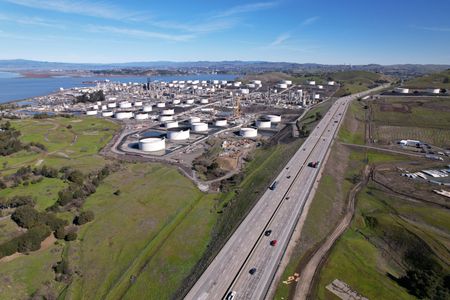By Scott DiSavino
NEW YORK (Reuters) – Oil prices jumped about 2% to a near 10-month high on Tuesday on a tighter supply outlook and OPEC optimism over the resilience of energy demand in major economies.
Brent futures rose $1.42 or 1.6%, to settle at $92.06 a barrel, while U.S. West Texas Intermediate (WTI) crude rose $1.55, or 1.8%, to settle at $88.84.
Both benchmarks remained technically overbought for an eighth straight day, and closed at their highest levels since November 2022.
The Organization of the Petroleum Exporting Countries (OPEC) stuck to its forecasts for robust growth in global oil demand in 2023 and 2024, citing signs that major economies are stronger than expected. OPEC’s monthly report forecast world oil demand will rise by 2.25 million barrels per day (bpd) in 2024.
“Crude prices are rallying after the OPEC monthly report showed the oil market is going to be a lot tighter than initially thought,” Edward Moya, senior market analyst at data and analytics firm OANDA, said in a note.
Keeping supplies tight, Saudi Arabia and Russia last week extended voluntary supply cuts of a combined 1.3 million bpd to year end. OPEC, Russia and allied producers are known as OPEC+.
OPEC member Libya shut four of its eastern oil export terminals due to a deadly storm, while OPEC+ member Kazakhstan reduced daily oil output for maintenance.
The U.S. Energy Information Administration (EIA) projected global oil output would rise from 99.9 million bpd in 2022 to 101.2 million bpd in 2023 and 102.9 million bpd in 2024, while world demand will rise from 99.2 million bpd in 2022 to 101.0 million bpd in 2023 and 102.3 million bpd in 2024.
That compares with a record 100.5 million bpd of global oil production in 2018 and a record 100.8 million bpd of world liquids consumption in 2019, according to the EIA’s Short Term Energy Outlook.
EIA said it expects global oil inventories to decline by almost a half million bpd in the second half of 2023, causing oil prices to rise with Brent averaging $93 per barrel in the fourth quarter.
In the U.S., EIA projected crude output would rise from 11.9 million bpd in 2022 to 12.8 million bpd in 2023 and 13.2 million bpd in 2024, while liquids consumption would rise from 20.0 million bpd in 2022 to 20.1 million bpd in 2023 and 20.3 million bpd in 2024.
That compares with a record 12.3 million bpd of U.S. crude production in 2019 and a record 20.8 million bpd of liquids consumption in 2005.
Looking ahead, oil traders are waiting for supply-demand forecasts from the International Energy Agency (IEA) on Wednesday, and U.S. oil inventory data from the American Petroleum Institute (API), an industry group, on Tuesday and from EIA on Wednesday.
Analysts polled by Reuters forecast a draw of about 1.9 million barrels of crude from U.S. stockpiles during the week ended Sept. 8. [EIA/S] [API/S]
That would be the fifth straight weekly draw, the longest such streak since January 2022.
INTEREST RATES AND INFLATION
U.S. consumer price index data for August on Wednesday should hint at the outlook for interest rates. The Federal Reserve is expected to leave rates unchanged at a policy meeting next week, though views are split over whether it will raise rates in November.
The European Central Bank will announce its interest rate decision on Thursday.
Interest rate hikes can slow economic growth and reduce oil demand.
(Additional reporting by Ahmad Ghaddar in London and Jeslyn Lerh in Singapore; Editing by Emelia Sithole-Matarise, David Goodman, David Gregorio and Timothy Gardner)

